

Article fait par :Claude Balmefrezol
Mis en ligne le

The MiG Saga
Mig jet plane 1rst generation MiG 9 et MiG 15
French Version
.jpg) |
| Internet |
The most important and the best know of the MiG production was upon Jet plane
But all has a beginning and now we try to tell this saga
During WW 2 the Soviet Union lagged Germany and Western allies in development of jet combat aircraft
At the end of the conflict major efforts were made to catch up.
MiG 9 Fargo
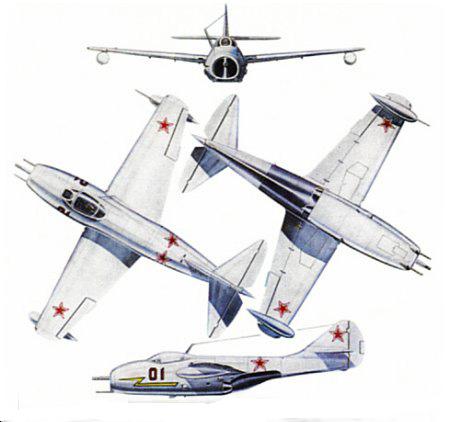 |
MiG-9 was roughly comparable to its contemporaries, such as the US Lockheed P-80 Shooting Star. However, aircraft design was moving rapidly at the time and the MiG-9's firstline service life was relatively brief
MiG-9 and other contemporary Soviet fighters were basically developed and put into production as fast as possible to help the USSR keep up with the West and gain some experience with jet aircraft, while designers worked on better designs.
MiG-9 saw no combat action, and the only export user was China, with a number of MiG-9s provided in 1950 as single-seat trainers
Development
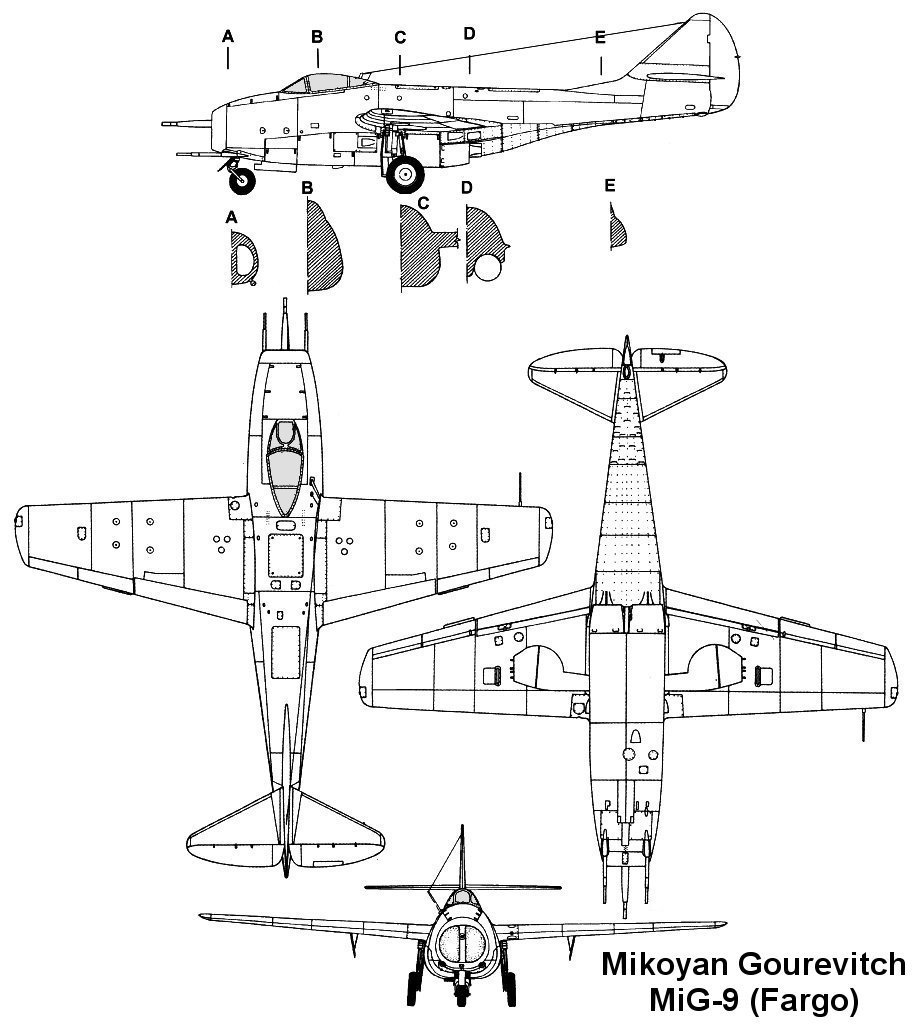 |
| Internet |
Tests were made with with "mixed power" aircraft, featuring both jet and piston engines
For MiG or OKB-155 a project was developed the I 250 a mixed-power fighter
He was a piston-powered fighter in which the piston engine drove a conventional propeller in the nose and a compressor in the rear fuselage, with the compressor feeding a combustion chamber to provide boost thrust.
As long as the piston engine was there, it might as well be used to drive the jet engine, eliminating the need for an exhaust turbine to drive the compressor.
About 16 I-250s were built, under the name of MiG-13
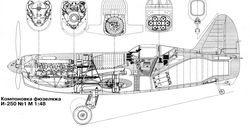 |
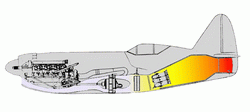 |
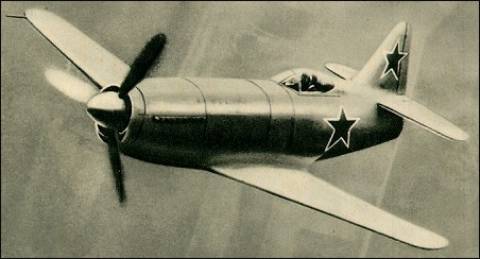 |
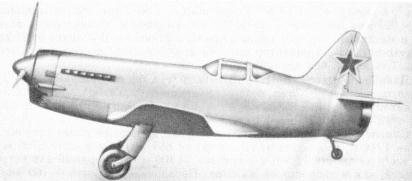 |
| MiG 13 Internet |
But this concept was it was a dead-end concept and went no further.
After MiG OKB under the German concept of rocket fighter build the I-270 a rocket-powered fighter prototypes,
In the same time Soviets obtained copies of Junkers Jumo-004 and BMW-003 jet engines from the defeated Germans, and these engines would provide a basis for the first generation of operational Soviet jet fighters.
The Jumo-004 were the RD (reactivniy dvigatel )10 and BMW-003 RD 20 and they were built by USSR
After a state requirement issued in February 1945 for a pure jet fighter MiG OKB developed a twin-engine, straight-wing aircraft the I-300
It was also referred to by the internal OKB code of "izdeliye F (model or product F)".
The first fly take place on April 24th 1946, . This fly was followed by the Yakovlev Yak-15 jet fighter, one hour latter .
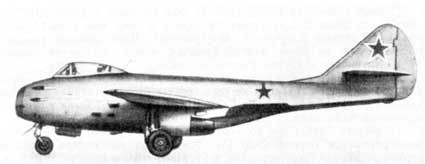 |
| MiG 9 |
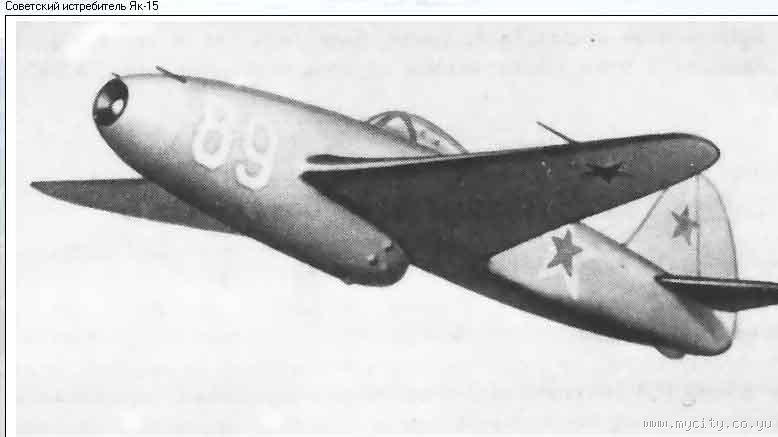 |
| Yak 15 |
The I-300 was of all-metal construction and had a "tadpole" configuration, with twin engines mounted in the lower fuselage, exhausting under a tail boom.
The low-mounted jet / tailboom configuration had been originally dreamt up by the Germans during the war, and the Soviets adopted it for a number of their early jet fighter designs. The underside of the tailboom was protected from the hot jet exhaust by a steel laminate heatshield, design of which proved tricky.
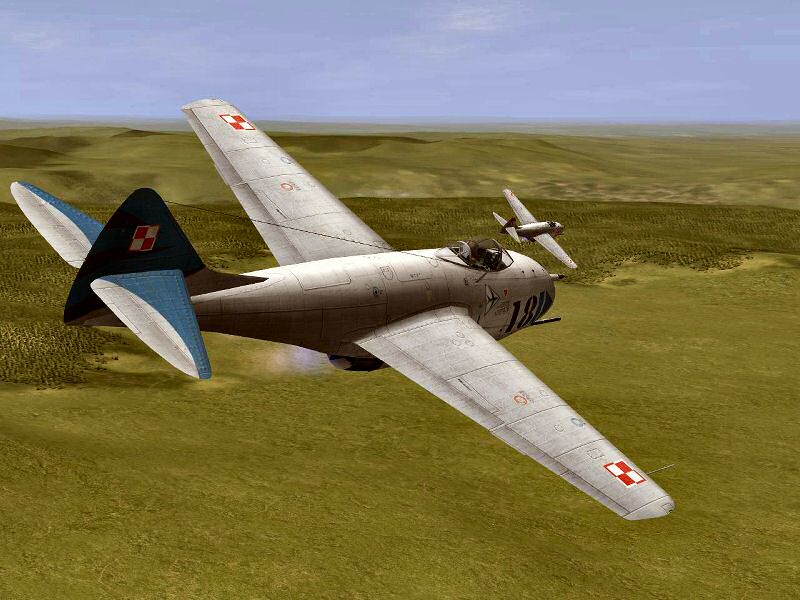 |
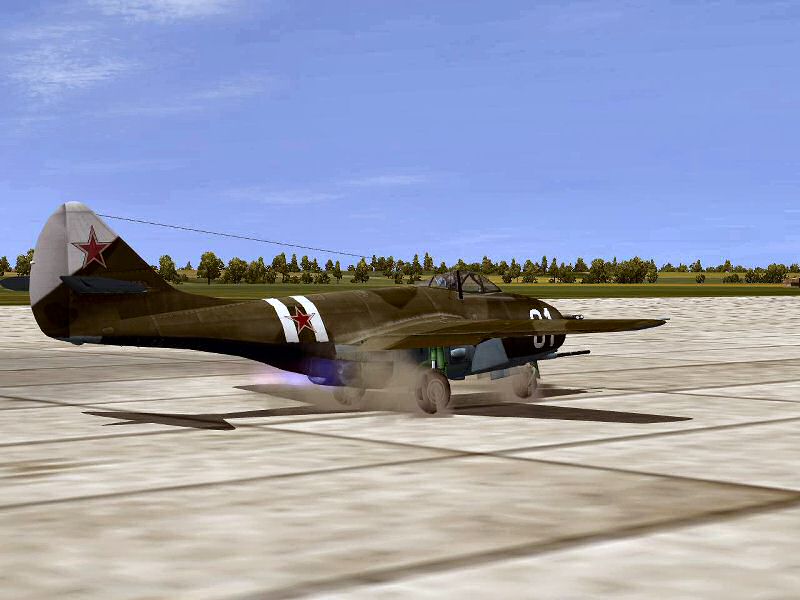 |
| Internet | Internet |
The I-300 featured mid-mounted straight wings with slotted flaps and delta-style tail surfaces; a bubble canopy with all-round vision and an armor-glass windscreen; and tricycle landing gear, making it one of the first Soviet aircraft with such a landing gear configuration. All gear assemblies had single wheels, with the nose gear retracting backward and the main gear retracting outward into the wings. The cockpit was unpressurized and featured armor plating. There was no ejection seat.
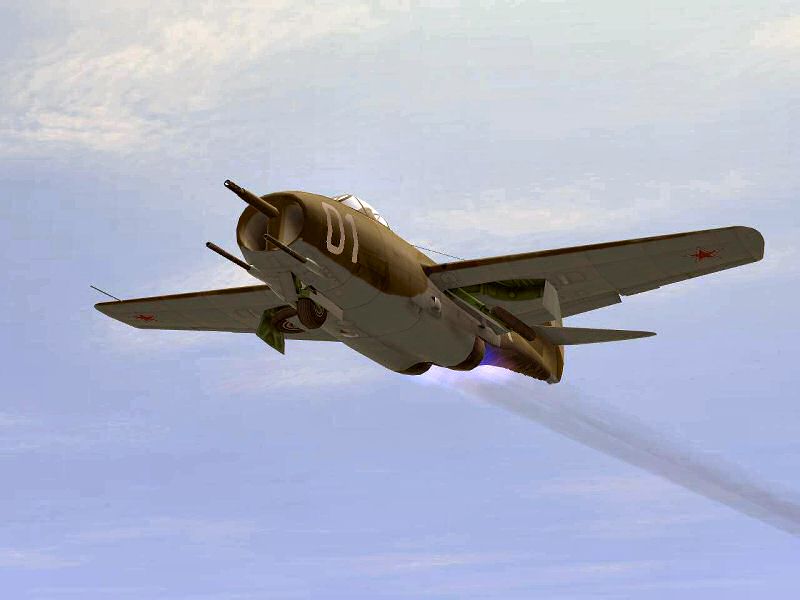 |
| Internet |
The I-300 was fitted with twin RD-20 turbojets with 7.85 kN (800 kgp / 1,760 lbf) thrust each; some captured German BMW-003s were also used.
The engine intake was in the nose of the aircraft, with a bulkhead in the intake dividing the airflow to each engine. There were four bag-type fuel tanks in the fuselage and three in each wing, providing a total internal fuel capacity of 1,625 liters (429 US gallons). Wingtip external tanks with a capacity of 250 liters (66 US gallons) each were also developed. Armament was initially planned to consist of a Nudelman N-57 57 mm cannon, mounted in the centerline engine intake bulkhead, and twin Nudelman-Suranov NS-23 cannon, firing out the lower lip of the intake. All three cannon had long barrels that stuck well out in front of the aircraft. The actual armament configuration of the three prototypes is a bit unclear; it appears they were initially flown with armament partially or completely replaced by ballast.
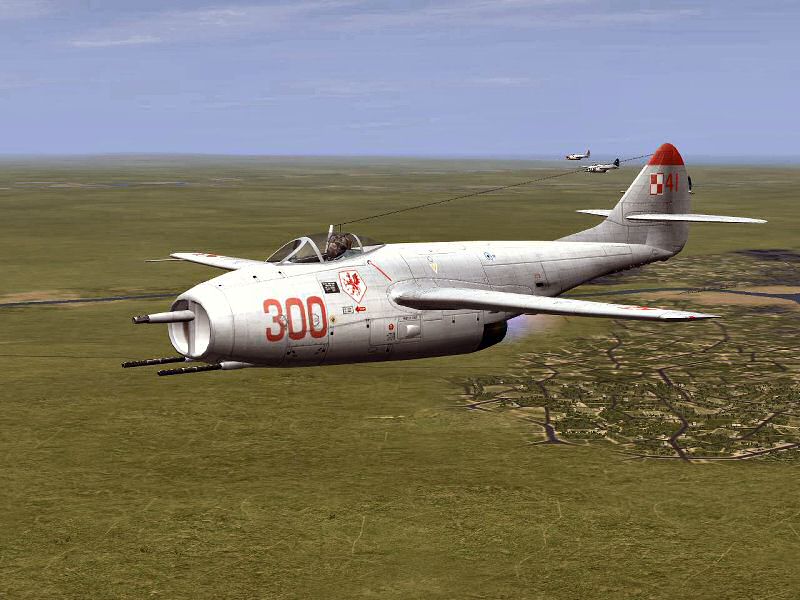 |
| Internet |
Although the I-300's excellent performance, much better than that of the best Soviet piston fighters, was obvious from the outset, it was also something new and unfamiliar, and to no surprise there were many teething problems with it, some of them deadly. Grinchik was killed in a crash on 11 July 1946 during a demonstration of all three prototypes to senior government aviation officials and VVS (Voyenno Vozdushniye Sily / Red Air Force) brass.
The positioning of the cannon was particularly naive, since it led to engine stalls caused by gun gas ingestion. The worst bugs were worked out while the MiG OKB built a batch of ten aircraft under a crash program, with the machines intended for a flyover of Red Square in November 1946 for the annual celebration of the Communist Revolution. The type had received the service designation of "MiG-9" by this time. The celebration was always used as a propaganda tool to show off the latest Soviet military hardware, and Soviet dictator Josef Stalin wanted to show that the USSR had fighters equal to those in the West. The fact that they weren't in full production at the time was not emphasized.
These ten aircraft amounted to preproduction machines; they featured an Nudelman N-37 cannon replacing the N-57 cannon. They were not really full production specification machines, since they still had a number of defects that had to be fixed before full production could start. The type went into VVS service in 1947, and a total of 610 was built in all, including prototypes and evaluation machines.
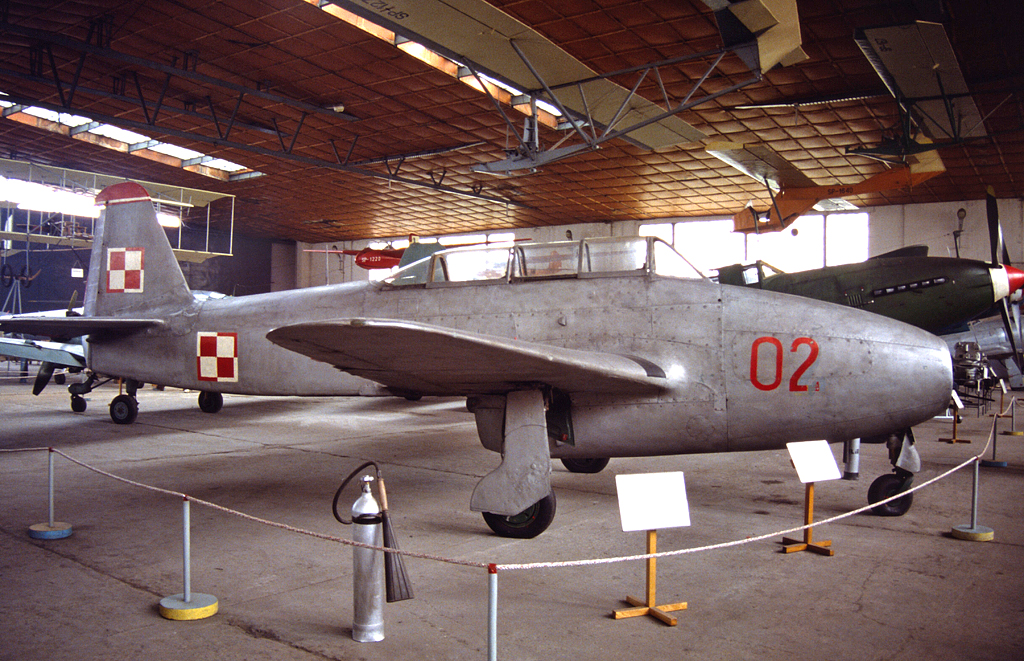 |
| MiG 9 UTI |
A two-seat trainer, the "MiG-9UTI", was designed, with two prototypes built, the first being a modification of one of the MiG-9 prototypes. Initial flight was in early 1947. The MiG-9UTI featured a tandem-seat cockpit with dual canopies, the front canopy hinging to the right and the rear canopy sliding back. It was to be fitted with full armament and ejection seats, with the ejection seat design derived from that used on the German Heinkel He-162 jet fighter and powered by an explosive cartridge. The rear seat cut the fuel load by a third. Trials showed the instructor's view from the rear seat to be unacceptable, but the need for a two-seat jet trainer was so great that the MiG-9UTI was approved for production in early 1948 anyway -- only to be cancelled a few months later, since much more advanced aircraft were becoming available.
Although the MiG-9M entered trials in July 1947, by that time it was clearly old news and the trials were abandoned in September. Work was also performed on building a derivative designated the "I-320" with the Rolls Royce Nene turbojet but this project was abandoned before the prototype was completed.
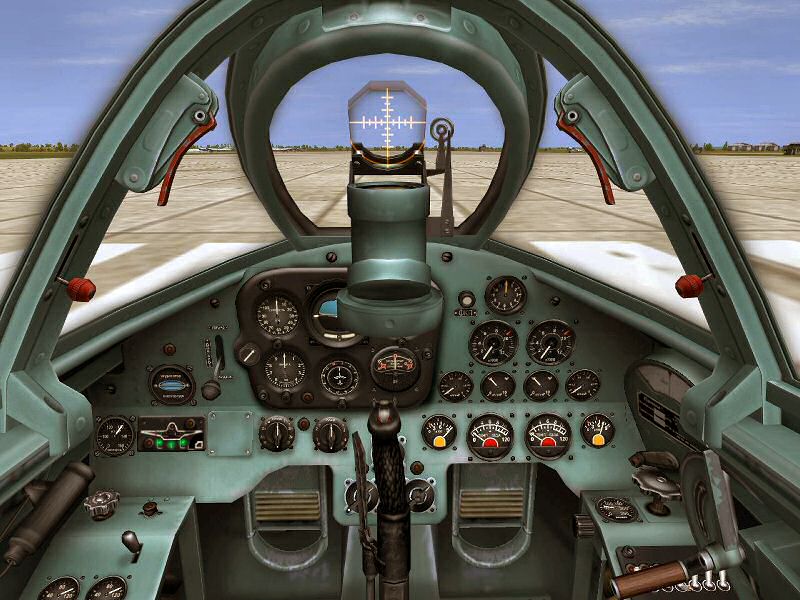 |
| Internet |
One very interesting subvariant of the MiG-9 that was actually flown was the "MiG-9L", a 1949 conversion of a single standard production MiG-9 to test the avionics for the "KS-1 Kometa" air-launched antishipping cruise missile (NATO codename "AS-1 Kennel"). Armament was removed; a radome was fitted in the nose for a radar transmitter; a small pod with a radar receiver was fitted to the leading inboard edge of each wing; a pod was fitted to the top of the tailfin for the missile radio control system; and a second cockpit with a small bubble-type canopy was fitted in the middle of the aircraft's back for a flight engineer
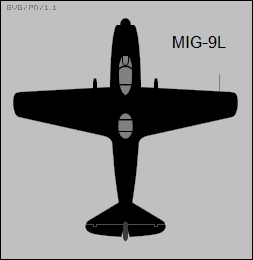 |
| Internet |
.
NATO eventually assigned the type the codename "Fargo"
Technical data MIKOYAN MIG-9
Empty weight 3570 kilograms
MTO weight 5070 kilograms
Crew 1
Wingspan 10.36 meters
Wing area 18.2 sq_meters
Length 9.98 meters
Height 2.98 meters
engine
Max speed 900 KPH
service ceiling 13000 meters
Range 11100 kilometers
Walk Around 1
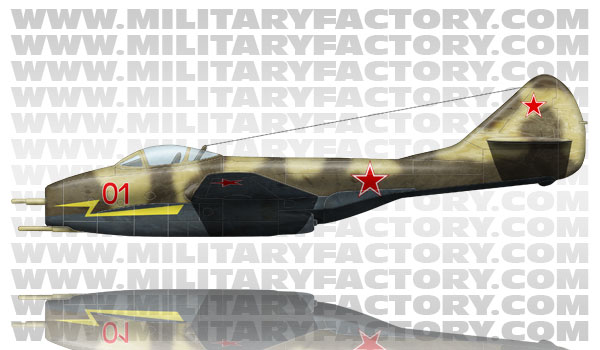 |
| Internet |
MIG15 the air power of the" Evil Empire"
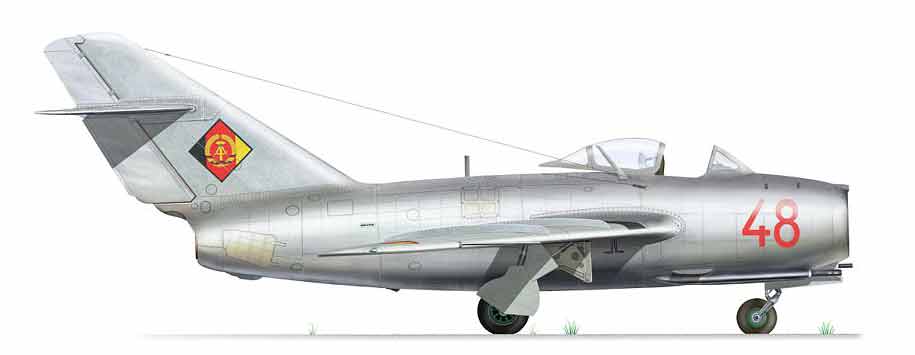 |
The MiG-15 was a formidable adversary of the West during the Korean War . MiG-15 was a very bad surprise for the West when it appeared in the skies over Korea. Where but its performance was far superior to any Western fighter. Its configuration, with a median swept wings, a tail and a top air intake nose seems to be inspired by the German Focke-Wulf Ta-183, an abortive German jet.
ORIGINS: THE I-310
I write for the MiG 9 that Ussr was lagged in the jet plane domain quickly USSR make progress on this domain of jet aircraft technology greatly by spying, foreign assistance with technology transfer .At the end of WW 2 British Prime Minister Winston Churchill had been replaced in office by Clement Atlee, and Atlee was nowhere near as suspicious of the Soviets as had been Churchill, a Bolshevik-hater of long standing. USSR receive some jet engines against British Royal Air Force and the Defense Ministry advices
USSR receive a license, technical data, and samples of the Rolls Royce Nene I, Nene II, and smaller Derwent 5 centrifugal flow turbojets,
The Nene I was put into production as the " Klimov RD-45", Nene II as Klimov RD-45F and Derwent 5 as Klimov D-500
At the end of WW2 were is 2 schools for Jet engines
1° German school with a axial flow design, with a compressor made of axial fan blades on a shaft.
Axial-flow engines would prove the way of the future for high-performance combat aircraft, but they were also tricky to get right and the Germans didn't have access to the materials needed to make them reliable.
2° German School who had focused on the simpler "centrifugal flow" engine, in which the compressor used an "impeller" like that of a water pump. The centrifugal flow engine would eventually be displaced by the axial flow engine for high-performance aircraft, but it was easier to build than an axial flow engine and British engines were much more mature than German engines.
In spring of 1947 MiG OKB receive an order to build a fighter basing upon the design on swept-wing research performed by the Tsentralniy Aerogidrodinamicheskiy Institut or "TsAGI Централный Аерогидродинамический Институт, ЦАГИ Central Aerodynamics and Hydrodynamics Research Institute" The project receive designation of "I-310".
First prototype was powered by a British-built Nene engine,
He make its first flight in july 1947 but he crash down and after modifications he fly on December 30th 1947
This aircraft receive the designation of "MiG-15" a few months later
A second prototype made its first flight on May 27th 1948, followed by a third on 17 July 1948. The three aircraft were put through trials, leading to authorization for production that summer.
A competing and roughly comparable fighter jet, the Lavochkin "La-15", was evaluated in parallel and was authorized for production as well, but it was harder to manufacture, and it was built in much smaller numbers than the MiG-15
The MiG-15bis entered VVS service in late 1950 and he was a A Rude Shock when USSR announcing its existence to the West with 45 MiG-15s overflying Moscow during the May Day parade of that year
NATO who assigned it the codename "Fagot-B", retroactively making the original MiG-15 the "Fagot-A The term Fagot would say bundle of wood for burning and not a pejorative for gay and effeminate men, or those presumed to be gay and effeminate
The MiG-15bis would become the main production variant
Description
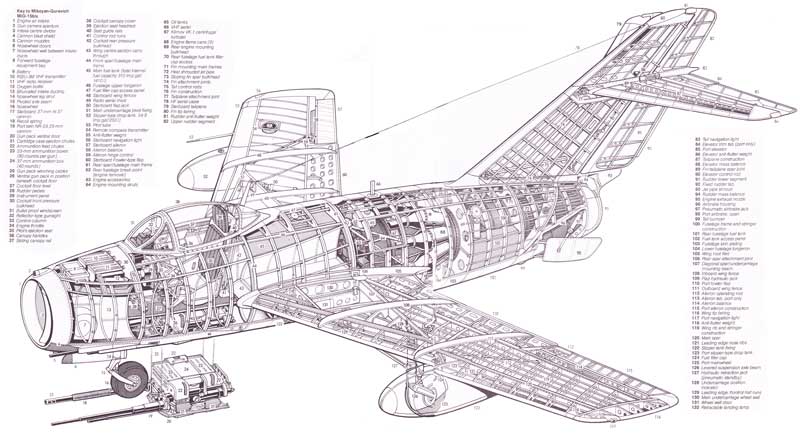 |
| Internet |
This aircraft was built as interceptor to destroy heavy bombers
The MiG-15 was clearly a generation ahead of the MiG-9,
This aircraft was characterized by a swept wing median of 35 °, the large tail, a very short fuselage and an air intake nose seems to be inspired by the Focke-Wulf Ta-183
He as all-swept flight surfaces. The wing, as mentioned, had a 35 degree sweep, along with an anhedral droop of 2 degrees and an incidence of 1 degree.
There were also two "fences" on the wing, to minimize airflow running down the wingspan and off the wingtips, which would have reduced the effectiveness of the control surfaces. Soviet aircraft designers would become fond of wing fences, with some jokers in the West claiming it was because they wanted to prevent the airflow from "defecting" over the ends of the wings. Western designers preferred a wing "dogtooth" to deal with the problem.
The tailfin had a sweep of 55.7 degrees and the tailplane had a sweep of 40 degrees. The flight control surface arrangement was conventional, and initially all control surfaces were unpowered.
Large number of changes were made to the MiG-15 Hydraulically-actuated air brakes were added to the rear fuselage on the third prototype, since the aircraft tended to become difficult to control in a high speed dive because it was in this epoca very difficult to manufacture the aircraft to be perfectly symmetrical, and so it had a tendency to roll to one side that became more noticeable at higher speeds.
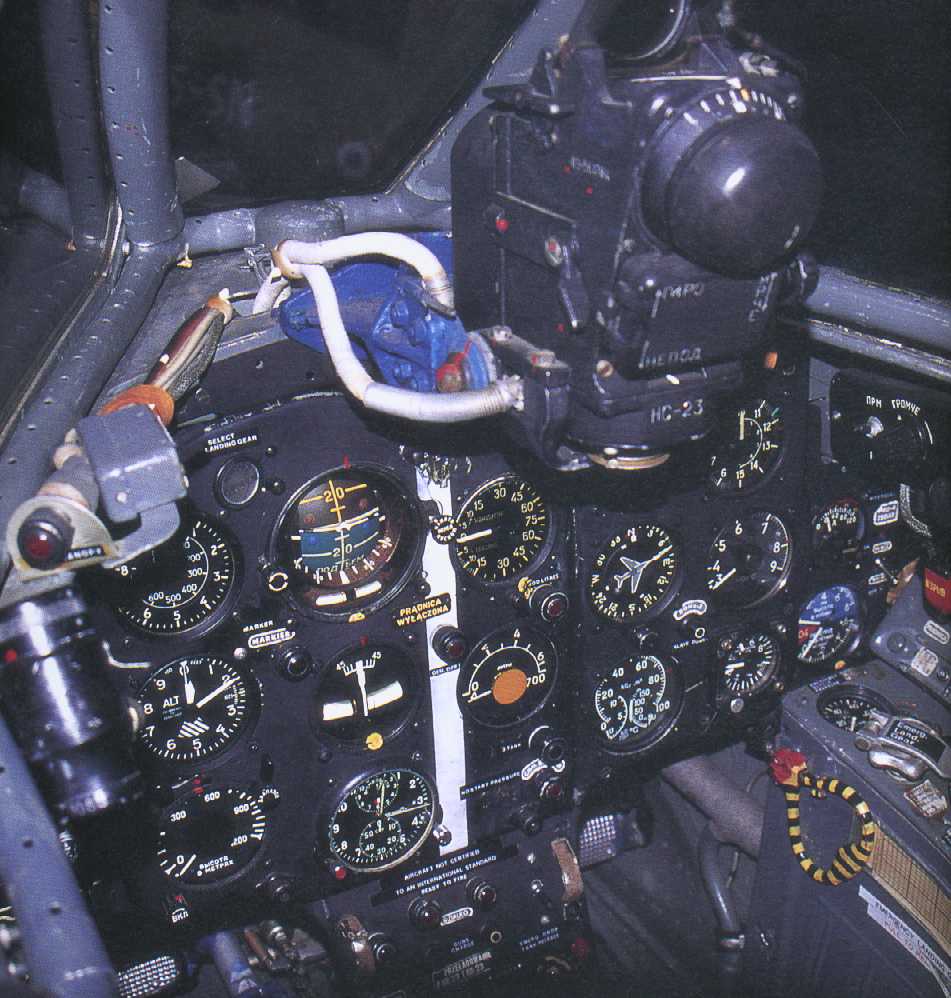 |
| Internet |
He had pressurized cockpit with a backwards-sliding bubble canopy and an ejection seat powered by an explosive cartridge, like the same as that used on the MiG-9UTI.
The cockpit was update with new control arrangement better climatisation , protection a new gunsigth , a modified canopy providing a better field of view a new Sirena-2 radar warning receiver (RWR); and an electrical engine self-starting system, with the eliminating of the need for a ground cart
For landing h receive a tricycle landing gear, all with single wheels, the nose gear retracting forward and the main gear hinging from the wings in towards the fuselage.
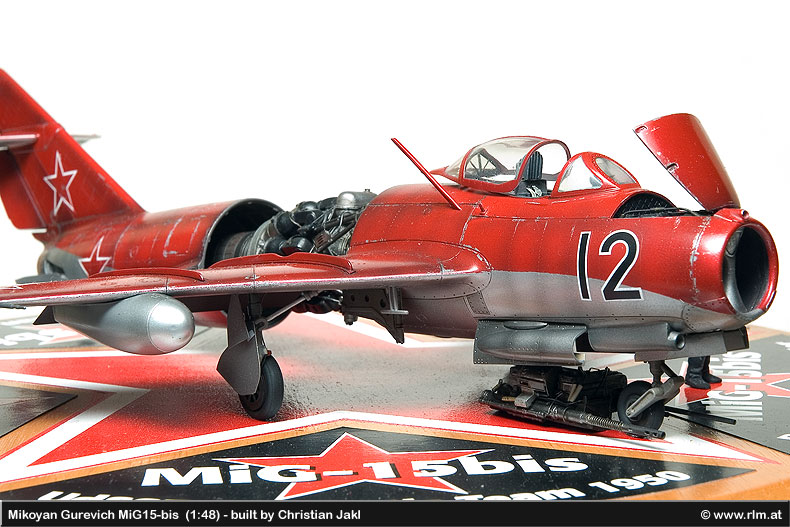 |
| Internet |
He as a rudimentary but efficient control for indicator of the gear down
A colored rod that protruded above the top of each wing when the landing gear were extended, and a similar "flaps down" indicator to the rear on the wing.
We found this simple but effective gimmick on some Soviet aircraft. Apparently there were cockpit dashboard indicator lights as well, the mechanical indicators serving as a backup
Cockpit as simple electronics suite including a radio, a radio compass, a radar altimeter, and an instrument landing system
In front of the aircraft the nose air intake with a bulkhead running down the middle, feeding an RD-45F centrifugal-flow turbojet with ,270 kgp of thrust. The rear fuselage could be pulled off for servicing the engine, with the break line at the hinge edge of the flaps.
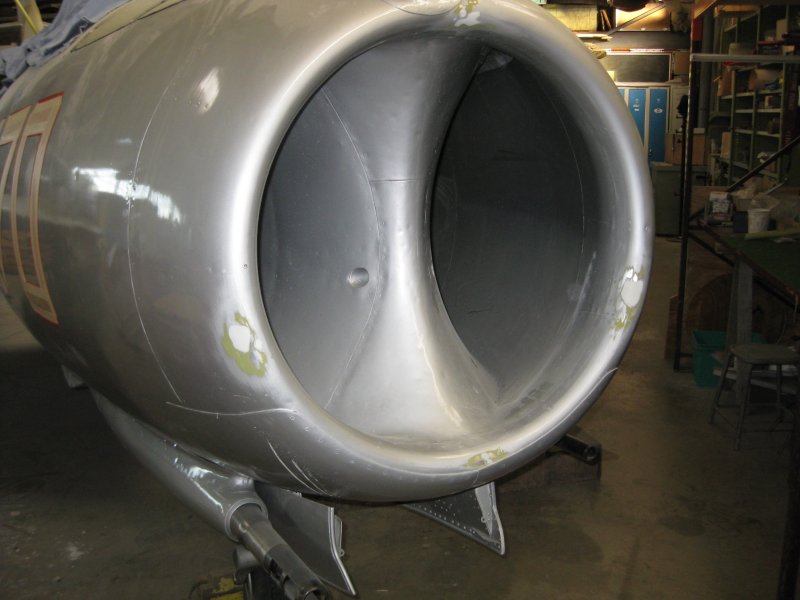 |
| Internet |
The Klimov engine OKB was a RD-45 engine The MiG-15bis demonstrated incremental improvement in performance all around. Along with the updated engine, (in particular a new engine fuel supply system that helped reduce the occurrence of flameouts at high altitude ) which had a slightly different form factor from the RD-45F and required some fuselage modifications,
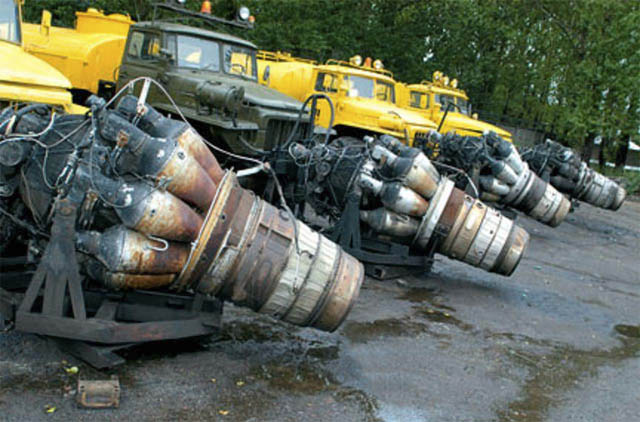 |
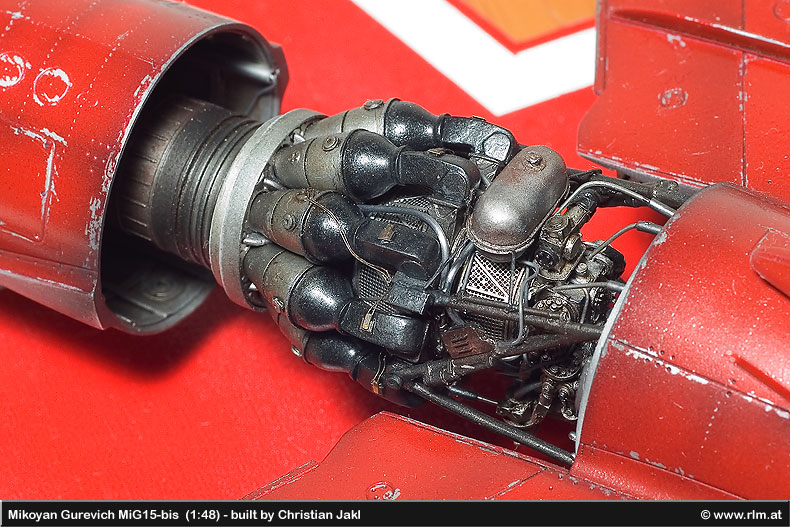 |
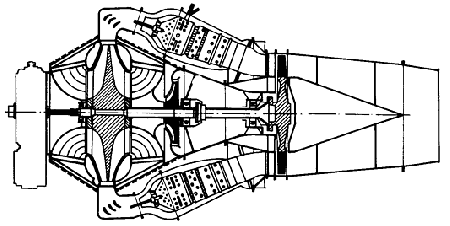 |
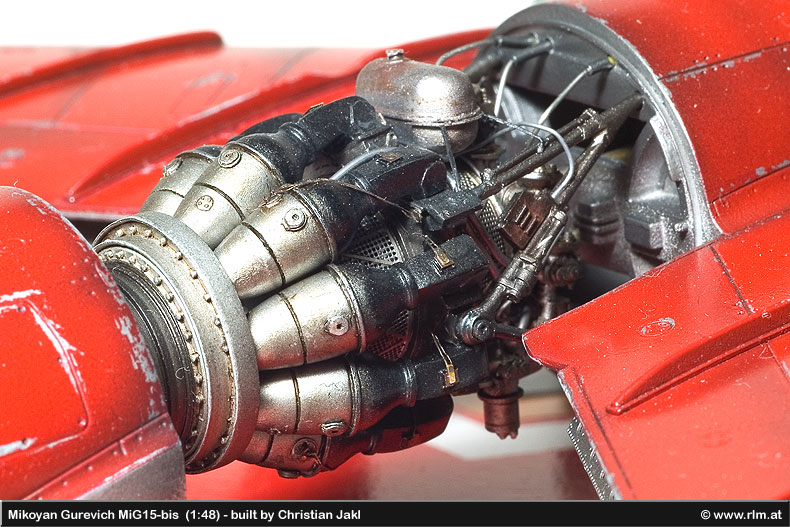 |
| Internet | Internet | Internet |
He was armed with a single 37 mm cannon firing from the right lower lip with a barrel of 40 rounds and two 23 millimeter cannon with a barrel of 80 rounds per gun firing from the left lower lip of the engine intake. This Nudelman-Richter NR-23 cannon replacing the NS-23 cannon, raise the rate of fire from 550 rounds per minute to 850 rounds per minute The NR-23 installation introduced little blisters on the fuselage behind the shell ejector ports, with the blisters designed to keep the spent shells from dinging the rear fuselage. If additional trays were available, swapping in a preloaded tray would help provide rapid combat turnaround.
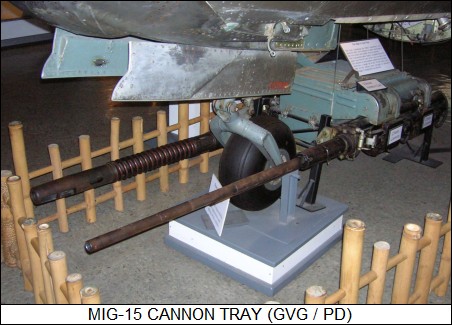 |
| Internet |
Latter MiG 15 was updated with the replacement of the NS-23 23-millimeter cannons with NP-23 23-millimeter cannons, providing a 50% higher rate of fire
A gun camera was mounted in the upper lip of the intake
MiG15 could also, in principle, carry a 100 kilogram bombs under each wing
The MiG-15 could be fitted with a "slipper"-type external tank under each wing.
There were three types of tanks available, with capacities of 250, 300, or 600 liters The slipper-type external tanks provided for the MiG-15 were replaced by a teardrop 400 liter tank that was carried on a pylon using bracing struts.They could be carried under either wing.
Later production teardrop tanks were fitted with twin tailfins to improve drop separation.
It appears that the MiG-bis could still carry the older slipper tanks. . A few MiG-15bis "Fagot-Bs" were built with a brake parachute and antiskid braking system, though this was not standard kit.
Variants ( Wikipedia)
I-310 : Prototype.
MiG-15 : First production version.
MiG-15P : Single-seat all-weather interceptor version of the MiG-15bis.
MiG-15SB : Single-seat fighter bomber version.
MiG-15bisS An "escort fighter" variant of the MiG-15bis, the "", was produced, the main change being carriage of a 600 liters external slipper tank under each wing. The big tank required wing modification. The MiG-15bisS also included a larger pilot oxygen supply and other tweaks. The big external tanks almost doubled the fighter's endurance. A total of 49 was built beginning in 1951.
MiG-15SP-5 : Two-seat all-weather interceptor version of the MiG-15UTI.
MiG-15T : Target-towing version.
MiG-15bis : Improved single-seat fighter version.
MiG-15bisP
MiG-15bis fighter was modified in 1950 to an all-weather interceptor configuration with "Toriy (Thorium)" radar in a large nose radome. The result had an appearance faintly reminiscent of the US F-86D Sabre; the aircraft was armed solely with a single 37 millimeter cannon, shifted closer to the centerline. The gun camera was relocated to the right side of the inlet. 5 new-build machines with the Toriy radar were built in 1951
Incidentally, five Lisunov Li-2 twin-piston transports, license-built copies of the Douglas C-47 Dakota, were fitted out as radar trainers. The exercise was abandoned because the Toriy radar was too complicated for the pilot to deal with while he was trying to fly the aircraft. The radar was also a completely unreliable piece of junk, the USSR having problems in manufacturing the required electronic components for the moment.
MiG-15bisR : Single-seat reconnaissance version.
It was fitted with a single vertically-mounted camera replacing one of the 23 millimeter cannon. It usually flew with the 600 liter long-range tanks. A total of 364 was built. Apparently there were a few other reconnaissance configurations, performed as experiments or conversions
MiG-15bisS : Single-seat escort fighter version.
MiG-15bisT : Single-seat target-towing version.
MiG-15bis-ISh" ground-attack aircraft
One of the most distinctive trials modifications was the "MiG-15bis-ISh" ground-attack aircraft, which featured a modified wing sporting large "beams" that were used to carry ordnance. About twelve were built, but since the rival Sukhoi OKB was developing dedicated ground attack aircraft at the time, the MiG concept went no further.
MiG-15 izdeliye SU In 1949, a MiG-15 designated "izdeliye SU" was modified with pivoting armament, consisting of a Shpitalny Sh-3 23 millimeter cannon on each side of the lower nose in a "cheek" fairing. The cannons could pivot up 11 degrees and down 7 degrees, and were aimed with a sight that provided automatic target tracking. Trials were performed in 1951 and the concept seemed to have merit, but it was not adopted for production
MiG-15UTI : Two-seat dual-control jet trainer
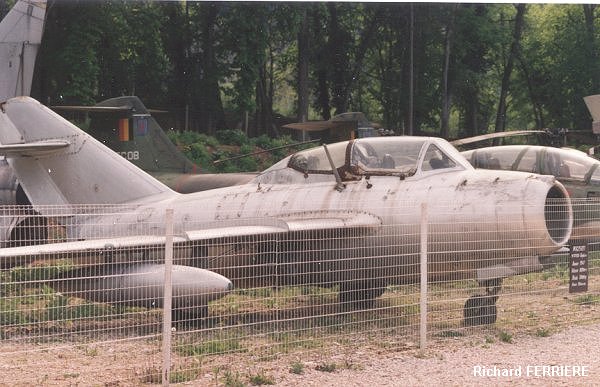 |
 |
| Internet | Internet |
.
Built to a need for a two-seat trainer issued in April 1949.this new-build prototype of a tandem-seat version of the standard early-production MiG-15 "Fagot-A" was built, performing its initial flight before summer. Trials proved the aircraft acceptable and it entered production in the fall of 1950 as the "UTI MiG-15" or "MiG-15UTI". He receive the NATO codename of "Midget".
The MiG-15UTI was also supplied to DOSAAF, a paramilitary organization that gave students outside the military flight training for a possible future career in the armed services
The tandem cockpit featured dual canopies, the one in front hinging open to the right and the one in the rear sliding backward. The rear cockpit was accommodated by reducing internal fuel storage.
The MiG-15UTI was the same length as the MiG-15 and he was powered by the RD-45F engine
This aircraft have has a reduced armament, originally consisting of one NR-23 23 millimeter cannon and a 12.7 millimeter machine gun; the 23 millimeter cannon was soon deleted from production.
The MiG-15UTI was produced in substantial quantities, becoming the standard advanced trainer for the USSR, Soviet satellites, and client states, and remained in first-line service well into the 1970s, long after the MiG-15 fighter itself was obsolete.
He was also called Babushka (Granny)" and "Matushka (Nice Old Lady)". It was also called a "Sparka" on occasion, but that name just meant "twin" and was applied to trainers in general.
Yuir Gagarin died on Mig 15UTI in 1967
MiG-15UTIP In 1950 a MiG-15bis fighter was modified to carry the "RP-1 Izumrud (Emerald)" radar. The Izumrud was less ambitious than the Toriy, being essentially a radar gunsight, and in fact the "RP" code meant "radiopristel (radio sight)". The Izumrud actually consisted of two radars, a search radar fitted in the upper intake lip, giving an appearance vaguely like the F-86E Sabre, and a tracking radar in a radome mounted on the intake splitter. Armament was reduced to the two 23 millimeter cannon, with a cannon on each side of the intake, and the gun camera was relocated to the right side of the inlet.
The modification featured a peculiar gun camera mounting on top of the canopy in what looked like a slightly oversized rear-view mirror housing, with the camera taking pictures through the gunsight using a mirror arrangement. The Izumrud radar was also fitted to three MiG-15UTI trainers, which were given the designation of "MiG-15UTIP". The Izumrud would not be fitted to any production MiG-15 fighters, but it would become a popular fit for the next generation of MiG fighters. Interestingly, in 1952 a MiG-15bis was fitted with a complete copy of the US AN/APG-30 radar gunsight used by the F-86, with the copy designated the "SRD-3 Grad (Hail)". The Izumrud radar turned out to be the better bet.
MiG-15 Burlak Experiments were performed in the early 1950s in which MiG-15bis fighters were towed on a cable behind a Tu-4 Bull heavy bomber, a copy of the US B-29 Superfortress, to provide long-range escort. The scheme was named "burlaki", after the teams of workmen who would pull barges upstream on a rope in Tsarist days. Technically burlaki worked, but the conclusion was that it wasn't very practical, since the pilot tended to freeze while under tow with his engine off, and there was the problem of finding the bomber and linking back up again after combat
MiG-15bis modified for midair refueling
In an attempt to provide a better solution to the long-range escort problem, in 1953 a number of MiG-15bis fighters were modified for midair refueling by installing a refueling probe above the upper left lip of the intake. Refueling was performed by Tu-4 Bulls with twin hose-and-drogue assemblies. The scheme was perfectly workable, but the Soviets would tend to assign midair refueling a relatively low priority and resources, probably because their need for it was less than that of the US, and as far as the MiG-15 went, midair refueling would never amount to anything more than an experiment
MiG-15M radio-controlled target drones A number of MiG-15 fighters were converted to radio-controlled target drones after the end of the first-line service of the type. They were designated "MiG-15M" or "MiG-15Msh", where "M / Msh" stood for "Mishin (Target)
Chinese MIG
J-2 : Chinese designation of the MiG-15 single-seat fighter.
JJ-2 : Chinese designation of the MiG-15UTI two-seat jet trainer.
J-4 : Chinese designation Chinese never built the MiG-15 or MiG-15bis, though large numbers of Soviet-supplied MiG-15bis machines were supplied to the Chinese People's Liberation Army Air Force (PLAAF).
Some J2 were passed on to Chinese client states.
The Red Chinese did however, build the MiG-15UTI, designating it the "JJ-2". It served with the PLAAF into the 1970s. The JJ-2 was also exported to Chinese client states under the designation of "FT-2".
Polish MIG
Lim-1 : MiG-15 227 jet fighters built under license in Poland.
Lim-1A : Polish-built reconnaissance version of the MiG-15 with AFA-21 camera.
Lim-2 : 500 MiG-15bis built under license in Poland, with Lis-2 (license VK-1) engines.
Lim-2R : Polish-built reconnaissance version of MiG-15bis with a place for a camera in the front part of the canopy.
SB Lim-1 : Polish Lim-1 converted to equivalent of MiG-15UTI jet trainers, with RD-45 jet engines.
SB Lim-2 : Polish Lim-2 or SBLim-1 converted to jet trainers with Lis-1 (VK-1) jet engines.
SBLim-2A or -2Art: Polish-built two-seat reconnaissance version, for correcting artillery.
Poland was the first to build the type outside of the USSR. Following assembly of a number of Soviet-supplied knockdown kits, the WSK factory at Mielec began production of the MiG-15 in 1952
the "LIM-1", with about 227 built in all, and WSK rolling production to the MiG-15bis in late 1953 as the "LIM-2", with 500 built. The RD-45F and VK-1 engines were also license-built by WSK Rzezow in Poland as the "LIS-1" and "LIS-2" respectively
Some LIM-2s built in a reconnaissance configuration and designated "LIM-2R". Some LIM-1s were upgraded with the improved avionics of the later-production MiG-15bis and were known unofficially by the designation of "LIM-1.5". A few LIM-1s and LIM-2s were operated as target tugs by the simple measure of fitting them with a hook for a target sleeve behind the nose gear door
Some sources claim that a small of LIM-2s and maybe some LIM-1s were exported to East Germany, but otherwise they were only operated by Polish forces.
The Poles did not build the MiG-15UTI, though apparently a number of LIM-1s and LIM-2s were factory-converted to the UTI configuration, to be designated "SBLIM-1" and "SBLIM-2" accordingly. A number were configured as battlefield reconnaissance / artillery spotting machines, with camera controls replacing the flight controls in the back seat, and designated "SBLIM-1Art" and "SBLIM-2Art". Two SBLIM-1s were also configured as ejection seat testbeds.
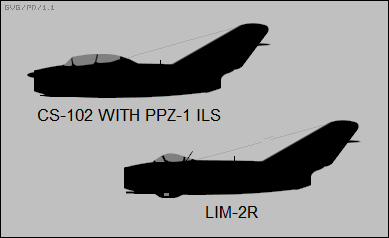 |
| Internet |
Czech MIG
S-102 : MiG-15 821 jet fighters built under license in Czechoslovakia.
S-103 : MiG-15bis 620jet fighters built under license in Czechoslovakia.
CS-102 : MiG-15UTI 2013 jet trainers built under license in Czechoslovakia
Czechs were the most enthusiastic foreign manufacturer of the MiG-15 series
Czechoslovakia produced the MiG-15 as the "S-102", with 821 built; followed by the MiG-15UTI as the "CS-102", with 2,013 built; and the MiG-15bis as the "S-103", with 620 built. Some of the CS-102 "Midgets" featured a 23 millimeter cannon instead of a 12.7 millimeter machine gun. In the late 1950s the Czech designations were dropped and these machines reverted to their original Soviet designations. The RD-45F and VK-1 engines were also built in Czechoslovakia, by the Motorlet organization. Czech-built MiG-15s were used in the USSR and exported around the world. They were regarded as the best-built MiG-15s, since the Czechs had a long tradition of precision manufacturing. A number of modifications were performed on the Czech machines:
Some Czech MiG-15 and MiG-15bis fighters were converted to target tugs by removing their armament and fitting them with a tow target winch. These machines were designated "MiG-15T" and "MiG-15bisT" respectively.
Some Czech MiG-15 "Fagot-A" machines were also converted to a fighter-bomber configuration, the "MiG-15SB", with three stores pylons under each wing instead of one.
They also had a brake parachute and provision for twin rocket-assisted take-off (RATO) boosters, making them the only MiG-15 machines with RATO capability. Czech-built MiG-15bis machines were converted to a similar configuration, though without provision for the RATO gear, and were accordingly designated "MiG-15bis-SB".
One MiG-15bis-SB was modified to carry the K-13 (NATO AA-2 Atoll) air-to-air missile (AAM), but this armament scheme was never used operationally on the MiG-15.
Some of the Czech modifications of MiG-15s were similar or identical to Soviet modifications, including a MiG-15bisR photo-reconnaissance variant, with some variations in configuration; a single MiG-15UTIP trainer with Izumrud radar; MiG-15UTI ejection seat testbeds; and radio-controlled target drones similar to the MiG-15M..
Raduga KS 1 Komet: An Air launched anti-shipping cruise missile.
Nicknames
Fagot / Midget (NATO Codename for MiG-15 and MiG-15UTI trainer, respectively)
Matushka ("Mother")
Baboushka ("Grandmother")
Jaguar (Hungarian AF nickname for MiG-15)
Eagle (Hungarian AF nickname for MiG-15bis)
MIG-15 IN SERVICE
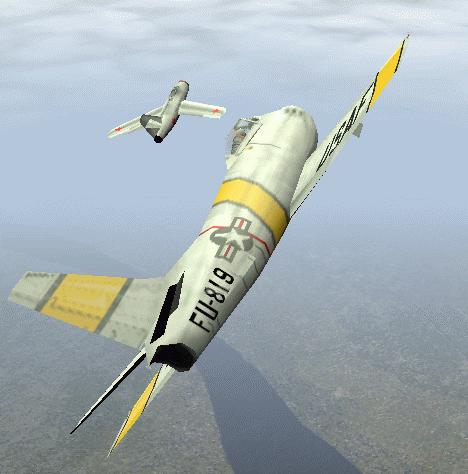 |
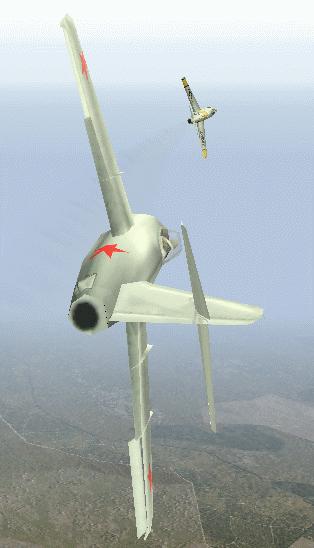 |
| Dog Figth Internet | Dog Figth Internet |
A Rude Shock
In the early days of the Korean War, the fast, high-climbing little MiG, code-named Fagot by NATO, came as a rude shock to the Americans. Armed with .23 and .37-mm cannons, it shot down a number of B-29s, and forced the USAF to halt daylight bomb raids. The MiG-15 was clearly superior to the American F-80 and P-51 fighters then in Korea, since the arrival of the F-86 Sabre, America's first swept-wing fighter,
When he arrived in Korea, the tables were turned. Although the MiG could outclimb the Sabre at altitude, it couldn't match its roll rate, turn radius, or visibility. Better-trained Sabre pilots racked up a claimed kill ratio of 14:1 against the MiGs. (The Russians have since claimed the MiGs' kill ratio was superior.) Bragging rights aside, the epic MiG/Sabre dogfights in "MiG Alley" along the Yalu River are among the most storied in air combat history.
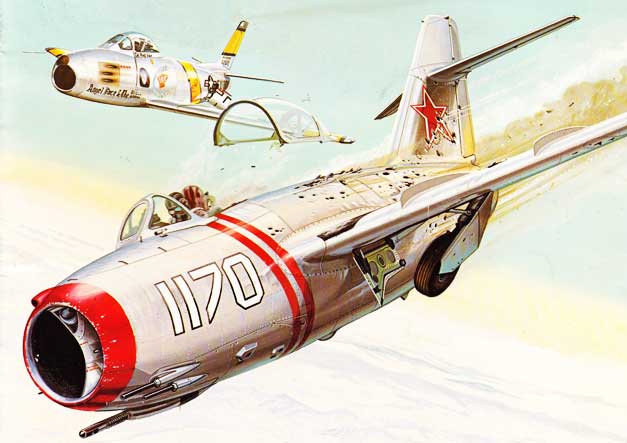 |
| Dog Figth Internet |
AIRCRAFT LOSSES
The Soviets claimed a total of 1300 UN aircraft destroyed during the war. They claim 345 Migs lost in combat and accidents. FEAF claims 792 Migs destroyed and 58 Sabres lost. After the war the USAF admitted to 103 Sabres lost, and the Mig kills at 379
the MiG-15 became the standard fighter plane of the air forces in the Communist Bloc, and many neutral nations as well
At the outset of the Korean War on 25 June 1950, the North Korean Air Force was equipped with piston-powered aircraft provided by the USSR, such as the Yakovlev Yak-9 and Lavochkin La-11. Once the Americans and their allies got organized, they swept the North Koreans out of the sky. However, in November 1950 the US was alarmed to be confronted by a new, advanced jet fighter that was heavily armed and left US Air Force (USAF) Lockheed F-80 Shooting Star and Republic F-84 Thunderjet fighters in the dust. The MiG-15 had arrived, with Soviet pilots flying the aircraft. The USAF quickly shipped new F-86 Sabres to the battle theater to confront the MiG-15s, and the struggle for air supremacy was on.
Follow 3 yars of dof figths in the “MiG Alley" along the Yalu River
Late in the war, the Americans dropped leaflets over enemy airfields offering $100,000 USD to any pilot who would defect with a MiG-15. The exercise was codenamed Operation MOOLAH, with "moolah" being an antique American slang term for "big money".
On September 21st 1953 Lieutenant Ro Kim Suk of the North Korean Air Force decide to defect and flew his MiG-15bis south The aircraft was evaluated by famed USAF test pilot Chuck Yeager Ro Kim Suk's MiG is now on display at the US Air Force Museum in Dayton, Ohio.
After Korean War Soviet MiG-15s would continue to see action for a few years after the war in encounters with Western spy planes that occasionally intruded into Soviet airspace.
MiG-15 was the standard Soviet air combat fighter of the early 1950s and it was accordingly supplied in large numbers to Warsaw Pact nations, as well as to almost every Soviet client state in Africa and Asia. The MiG-15UTI continuing to be exported long after the MiG-15 and MiG-15bis were obsolete
In Far East Red Chinese MiG-15s occasional encounters with Taiwanese F-86s and other Taiwanese aircraft during the early 1950s, with both sides claiming kills.
In Middle East Egypt and Syria were equipped with MiG-15 "Fagot-A" and MiG-15bis "Fagot-B" fighters from the mid-1950s, and these aircraft would see combat in the 1956 and 1967 Arab-Israeli Wars. They claimed some kills during the 1956 war, but they were largely destroyed on the ground in the opening blitz of the 1967 war. A few Egyptian MiG-15s did perform ground-attack sorties during the 1967 war, but these missions were suicidal, since by that time the MiG-15 was hopelessly obsolete for air combat and no match for Israeli fighters.
The last military operator of the MiG-15 was Albania, which operated a handful of MiG-15bis and MiG-15UTI machines up to late 2005.
Number built
12,000 + 6000 in license total 18000
Technical data MIKOYAN MIG-15
Empty weight 3681 kgs
MTO weight 6045kgs
Crew 1
Wingspan 10.80 meters
Wing area 18.2 sq_meters
Length 10.86 meters
Height 3.7m
engine 1 Kimov VK turbo jet
Max speed 1075km/h
service ceiling 15500 meters
Range 1860kilometers
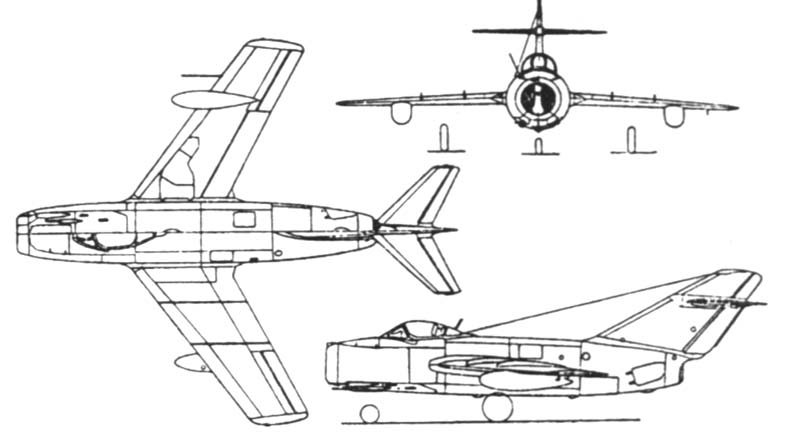 |
| Internet |
Walk Around 1 2